Roku Overheating
In the dynamic world of digital streaming, Roku has emerged as a leader, offering a versatile range of devices that cater to every entertainment need. Despite its immense popularity and user-friendly interface, a recurring challenge that some users face is Roku overheating.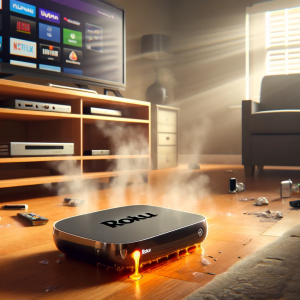
Roku device overheating can manifest as more than just an inconvenience; it is a critical issue that demands immediate attention. When these devices overheat, they are not only at risk of hardware damage but also suffer from performance setbacks such as lagging, freezing, or unexpected shutdowns. This common issue of Roku overheating disrupts the streaming experience, potentially leading to permanent device damage if not properly managed.
Understanding and addressing the causes of Roku device overheating is essential for maintaining the device’s longevity and ensuring optimal performance. By recognizing the early signs of overheating and implementing preventive measures, users can safeguard their investment and enjoy uninterrupted streaming. This guide aims to arm Roku users with essential knowledge and practical tips to tackle Roku overheating, enhancing their overall viewing experience.
Signs That Roku Device is Overheating
Identifying the early signs of Roku overheating is crucial for taking timely action to protect your device.
- Users may first notice that their Roku device is unusually hot to the touch. This is a clear physical indication that the device is not just warm from standard operation but is potentially overheating. This excessive heat can be particularly evident in compact spaces or during prolonged streaming sessions.
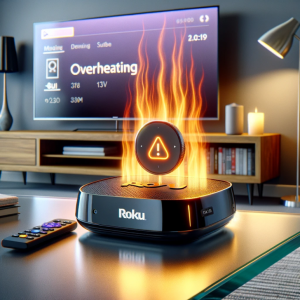
- Additionally, Roku has built-in safety features to alert users about temperature issues. A Roku overheating message may appear on your screen if the system sensors detect that the internal temperature has exceeded safe operational levels. This warning is designed to catch your attention quickly to prevent any damage by advising immediate power down.
- Performance degradation is another key indicator that your Roku device may be overheating. If you find that your device frequently freezes, experiences lag, or unexpectedly reboots, it could be due to the strain of high temperatures on the device’s hardware. Such disruptions not only affect your viewing experience but also signal that something may be wrong internally, often related to Roku device overheating.
For those using TVs, the Roku TV overheating message operates similarly, providing an on-screen alert that the television needs to cool down. Regardless of whether the message appears on a Roku streaming stick or a TV, it’s a critical warning that should not be ignored.
If you’re saying to yourself that my Roku is overheating, it’s time to take immediate steps to mitigate the issue. Recognizing these signs early can help prevent the negative consequences of Roku device overheating, such as system failure or irreversible damage. In the following sections, we’ll explore practical steps you can take to address and prevent overheating to ensure your Roku continues to operate efficiently and safely.
Causes of Roku Overheating
Understanding the causes of Roku device overheating is essential for preventing this common issue and ensuring the longevity of your streaming device. Roku Overheating can stem from a variety of aspects, both internal and external, that can impact different models from the Stick to the Roku Ultra.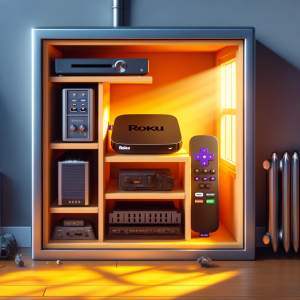
-
Internal Factors responsible for Roku Overheating
At the heart of many overheating issues are internal hardware malfunctions or failures. Over time, components within the Roku, such as the processor or power supply, can degrade. This degradation can lead to inefficiencies that cause the device to generate excess heat. In particular, Roku streaming stick overheating can be prevalent due to its compact design, which crams powerful technology into a small space, leaving less room for effective heat dissipation.
-
External Factors responsible for Roku Overheating
External environmental conditions significantly contribute to Roku device overheating. Poor ventilation is a major external factor; when Roku devices are placed in areas with restricted airflow, such as tightly packed entertainment centers or closed cabinets, they cannot cool down adequately. Additionally, exposure to direct sunlight can dramatically increase the temperature of devices like the Roku Express overheating, further exacerbating the risk of overheating.
-
Placement Issues responsible for Roku Overheating
The physical placement of Roku devices plays a crucial role in their thermal performance. Placing a Roku device in enclosed spaces or in close proximity to other heat-generating electronics can lead to a buildup of ambient temperature, which is particularly challenging for devices like the Roku Ultra overheating. The heat generated by other electronics can accumulate around the Roku, pushing its temperature beyond safe operational levels.
The association of these internal and external factors can cause significant overheating problems across all Roku models, from the Roku Stick overheating to the TV overheating. Awareness of these factors and proactive management of the device’s environment are key to preventing overheating and maintaining optimal functionality of your Roku. In the next section, we will explore immediate steps you can take if you notice any signs of Roku device overheating.
Immediate Steps to Take For Roku Overheating
When you notice signs that your Roku is overheating, taking swift and effective action is crucial to prevent damage to your device. Here are immediate steps to cool down your Roku and ensure it returns to a safe operating temperature.
-
Turn Off and Unplug the Roku Device
The first step should always be to turn off your Roku device and then unplug it from the power source. This action stops the generation of heat and begins the cooling process. Overheating can cause internal damage, so it’s vital to allow the device time to cool down before restarting. If you face Roku overheating issue, this simple step can often prevent more serious issues caused by continuous heat exposure.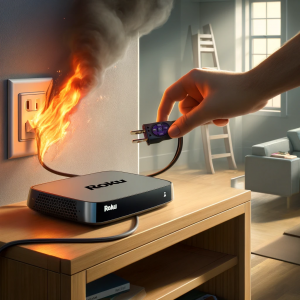
-
Move Roku to a Cooler, Ventilated Area
Once the device is powered down, move it to a location with better air circulation. A cooler, ventilated area will help dissipate the heat more effectively. Avoid placing your device on soft surfaces like beds or sofas, which can block air vents leading to overheating Roku . Hard surfaces in open areas are ideal because they allow air to flow freely around the device, aiding in the cooling process.
-
Avoid Enclosure of Roku Device in Tight Spaces
Ensuring that your Roku isn’t enclosed in a tight space is critical for long-term heat management. Enclosures not only trap heat but also restrict airflow, which is essential for maintaining a moderate device temperature. If you suspect that Roku device is overheating because of its placement, consider relocating it to a more open space. Ensure there are several inches of space around it, especially near the vents, to facilitate proper ventilation.
By following these steps immediately after noticing the Roku overheating issue, you can help protect your device from the adverse effects of excessive heat. These preventive measures are simple yet effective and can significantly increase the life and functionality of your Roku. In the following sections, we will discuss more long-term solutions to prevent Roku overheating issue in the future.
Long-Term Solutions to Prevent Roku Overheating
To ensure your Roku device remains cool and functional over its lifespan, it’s crucial to implement long-term strategies that prevent Roku overheating. Addressing the placement of your device, controlling environmental conditions, and possibly enhancing cooling with accessories can all contribute to maintaining an optimal operating temperature. Here are some effective strategies:
-
Proper Placement Tips to prevent Roku Overheating
Placement is paramount in preventing Roku overheating. Keep your Roku device away from other heat-generating electronics like game consoles, routers, or cable boxes, as these can significantly raise the temperature of your streaming device. Additionally, avoid placing it in areas where it will receive direct sunlight, especially during peak hours, as this can cause the device’s temperature to spike unnecessarily.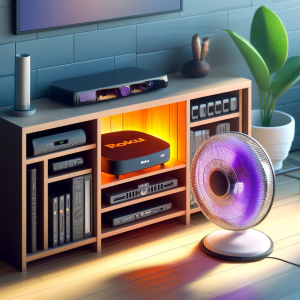
-
Optimal Temperature to prevent Roku Overheating
Maintaining a room temperature of about 68-72 degrees Fahrenheit (20-22 degrees Celsius) is ideal for electronic devices, including Roku. Excessive heat and high humidity can both lead to overheating Roku devices. If you live in a particularly hot or humid climate, consider using air conditioning or a dehumidifier in the room where your Roku is located to help control the ambient conditions.
-
Accessories to Enhance Cooling for Roku
For those situations where internal cooling is not sufficient, aftermarket cooling fans can be an excellent solution. These fans help to increase airflow around your Roku device, especially useful for models like the Roku Ultra that may process a lot of data and heat up quickly. Additionally, using heat sinks or improved thermal pads can also help dissipate heat more effectively, keeping your Roku cool during operation.
Implementing these long-term solutions will help ensure that your Roku device operates efficiently and remains free from the risks associated with overheating.
FAQs
Q1. What are the signs that my Roku device is overheating?
- A1. Key signs that your Roku is overheating include the device being unusually hot to the touch, an on-screen overheating warning, and performance issues like freezing, lagging, or unexpected reboots.
Q2. What causes Roku device overheating issue?
- A2. Roku device overheating issue is due to internal factors like hardware malfunctions and external factors such as poor ventilation, placement in direct sunlight, or proximity to other heat-generating electronics.
Q3. What should I do immediately if I notice my Roku device is overheating?
- A3. If you notice your Roku overheating, immediately turn off the device, unplug it, and move it to a cooler, well-ventilated area away from other electronics. Let the device cool down completely before restarting.
Q4. How can I prevent my Roku from overheating in the long term?
- A4. To prevent long-term Roku device overheating, ensure proper placement away from other electronics and direct sunlight, maintain a room temperature of 68-72°F (20-22°C), and consider using cooling accessories like aftermarket fans or heat sinks.
Q5. Why is it important to address Roku overheating issues quickly?
- A5. Addressing Roku device overheating issue quickly is crucial to prevent hardware damage, extend the lifespan of your device, and maintain optimal performance. Overheating can lead to permanent damage if not managed correctly, affecting your overall streaming experience.
Conclusion
Addressing Roku overheating issues is not just about improving your immediate streaming experience—it’s also about protecting your investment in the long term. Throughout this guide, we’ve explored the signs that indicate your Roku is too hot, the underlying causes of this heat buildup, immediate actions to cool down your device, and long-term strategies to prevent future overheating. Each step is crucial for maintaining the optimal performance and longevity of your Roku device.
It’s essential to remain vigilant and proactive in monitoring your Roku. Regularly check for any signs of Roku device overheating, such as the device being hot to the touch, performance lags, or unexpected restarts. Early detection can prevent the minor inconvenience of an overheating device from becoming a major disruption.
Finally, remember that taking swift action can make all the difference. Whether it’s repositioning your Roku to ensure better ventilation, adjusting room temperatures, or using cooling accessories, each measure contributes to a cooler, more efficient operating environment for your streaming device.
By staying informed and attentive, you can enjoy uninterrupted, high-quality streaming experiences without the hassle of dealing with overheating issues. Keep these tips in mind, and ensure your Roku continues to deliver the best performance possible.
To know more about Roku overheating and other issues and their solutions, visit our Roku Support Page.


Mary jones
What should I do when I receive a Roku overheating message while watching my favorite show?
Support Admin
Receiving a Roku overheating message during your viewing can be alarming. Immediately, stop using the device to prevent any damage. Turn off your Roku and unplug it from the electrical outlet. Let it sit in a cooler, well-ventilated space away from other heat sources for at least 30 minutes or until it feels cool to the touch. This cooling period is critical to ensure that the device’s internal components are not damaged by the excessive heat. After it has adequately cooled, consider relocating your Roku to an area with better airflow to prevent future overheating.
Michelle ramirez
My Roku stick overheating is a recurring problem. What long-term solutions can I implement to fix this permanently?
Support Admin
Recurring Roku stick overheating can be frustrating and may impact your device’s longevity. To address this issue long-term, ensure your Roku stick is not enclosed in an area that restricts airflow, such as behind the TV or inside a cabinet. Using a USB extender can help by allowing you to place the stick in a more open and cooler area. Additionally, consider adding a passive cooling element, such as a small heat sink, which can be attached to the Roku stick to help dissipate heat more effectively.